|
|
 |
|
| THE STORY So FAR |
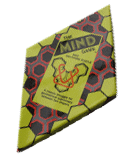 1988: The Mind Game
1988: The Mind GameThe first version of Tantrix was called the "Mind Game", named after the inventor's game shop. It used 56 cardboard pieces with a yellow background and lines of only two colours - red and black. The strange hexagonal playing board folded three ways into a diamond shape, which determined the shape of the box. A couple of thousand sets were silk screened in Chile and shipped back to New Zealand to test out sales in the inventor's shop. The set sold well enough to publish a second edition in the following year. This time an offset printing process was used, along with a number of minor improvements. Having his own game shops, Mike was able to "test the market" and get immediate feedback from customers to establish whether design changes were indeed improvements. An experiment with the first plastic version of the Mind Game followed a year later. The evolution towards Tantrix had begun. |
||
1991: Tantrix - The game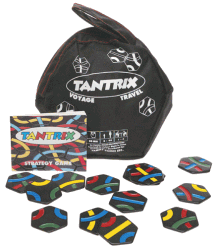 The board was discontinued, the name changed to Tantrix and the tiles upgraded to amino resin. The first few thousand games were hand-painted by the inventor in his garage in Christchurch and sold in a flat hexagonal box. Two more colours were added, allowing the game to be played by up to four players. In fact, some unusual colours were used at the time, including pink!
The board was discontinued, the name changed to Tantrix and the tiles upgraded to amino resin. The first few thousand games were hand-painted by the inventor in his garage in Christchurch and sold in a flat hexagonal box. Two more colours were added, allowing the game to be played by up to four players. In fact, some unusual colours were used at the time, including pink!The appearance of the game continued to change too. For a while, the game was sold in a cylindrical hex-box, eventually a travel bag was used (photo). The bag proved so popular, that a coloured version is still in use today. Early Tantrix games contained 8 tiles known as "Triple Intersections" (3 straight lines) - a legacy of the Mind Game. These tiles could only fit 3 different forced spaces because of their bilateral symmetry, and consequently slowed down the game. After plenty of play testing the decision was made to remove TI's in 1992. |
||
|
1991: Original Puzzle The first Tantrix Puzzle was called "Crazy Tantrix Original". It used 10 tiles with 3 different line colours, any of which could be made into a loop. The Original took most people between 15 to 45 minutes to solve. Before the Discovery was invented, Tantrix Original was the easiest way to learn and build the spatial skills needed to play Tantrix. |
||
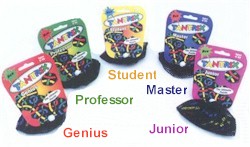 1994: Super 5 Puzzles
1994: Super 5 PuzzlesThe Super 5 puzzle range was a progression from the Original Puzzle. Five levels - Junior, Student, Professor, Master and Genius were designed and some of these puzzles (especially the Genius) were very hard indeed. All five puzzles had ten or twelve tiles each and a single objective. The puzzles could be purchased separately or assembled from a set of 56 Tantrix tiles by selecting the appropriate tiles. Junior, Student and Master are single loop puzzles, the Professor is a double loop puzzle and the Genius is a double line puzzle, the hardest twelve-tile Tantrix puzzle available. |
||
|
1996: Tantrix on the Internet In early 1996, Tantrix made its first appearance on the Internet. Two independent developments, the Tantrix inventor's site and InterNetivity's Tantrix applets (which allowed Tantrix to be played online in realtime) were merged and initially published under the name "Playtantrix.com", as Tantrix.com was unavailable at the time. A year later we were able to get hold of Tantrix.com which is the domain name currently used. |
||
1997: The Rock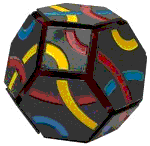 The Tantrix Rock is a 3-dimensional Tantrix puzzle made from hexagonal and square faces, which form the geometrical body of a "truncated octahedron". Rotatable and removable tiles are connected to each of the 14 faces. The simple objective is to match up the colours. Sounds easy?
The Tantrix Rock is a 3-dimensional Tantrix puzzle made from hexagonal and square faces, which form the geometrical body of a "truncated octahedron". Rotatable and removable tiles are connected to each of the 14 faces. The simple objective is to match up the colours. Sounds easy?There are just five correct solutions and over a billion billion wrong ways of doing it! Commercially the Rock was not a huge success and its sale was discontinued a few years later. |
||
|
1997: The CDROM (Windows) The development of the CDROM was a joint venture between Tantrix Games and a Nelson multimedia company specializing in titles with New Zealand themes. The program allowed to play Tantrix against the computer at various levels, as well as other human opponents. Incidentally, the ongoing development of the Tantrix.com server resulted in a free online playing option, with regular real-time updates - a tough competition - which eventually outdated the CDROM. It has been withdrawn from sale. |
||
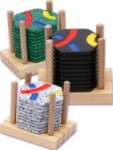 1999: Discovery Puzzle
1999: Discovery PuzzleThe 10-tile Discovery puzzle was perhaps the single best advance in the evolution of Tantrix, and yet effectively, the Discovery was designed by the players themselves. While demonstrating Tantrix at public fairs, a hand-numbered set was used to break the challenge of making large Tantrix loops into small steps - starting with 3 tiles and adding one tile at a time. This set was meant for demonstration purposes only, but soon the players recognised that they were given a pre-determined sequence of tiles and could not wait to be given the next one! Realizing that this step-by-step concept was addictive, a puzzle was designed which used increasing levels of difficulty - the Discovery. We did not realise it straight away, but soon found that it was possible to add multiple sets together and continue building loops of 20, 30 or even 30 million tiles. Amazingly, the Discovery sequence is infinite! The Discovery is available in mesh bags or "coffee-table" stands, and in a range of differently coloured tiles. The stands are made from wood or chrome and allow for the tiles to be stacked in sequence. |
||
2000: The Game Pack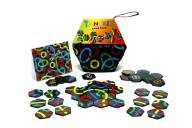 The Tantrix Game Pack has become our flagship product. It was a major improvement compared to the previous "Classic" set, the most significant advance being the engraved numbers on the back of each tile for easier identification. The contents of the Tantrix booklet included with the Game Pack are also under constant revision - the english version is now in its 10th edition.
The Tantrix Game Pack has become our flagship product. It was a major improvement compared to the previous "Classic" set, the most significant advance being the engraved numbers on the back of each tile for easier identification. The contents of the Tantrix booklet included with the Game Pack are also under constant revision - the english version is now in its 10th edition.The Game Pack includes the best puzzles and games from over 20 years of Tantrix development, such as the Discovery, the Super 5 Puzzles, the 2 "Unsolved Puzzles" and of course the multiplayer strategy game itself. A complete set of 56 tiles can also be split up into 5 individual "Rainbow Puzzles" according to the colour-coding on the reverse of each tile. For more details on the Tantrix Game Pack, browse the product page. |
||
2002: Xtreme Puzzle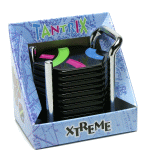
The Xtreme was designed as a harder version of the Discovery to meet the inevitable demand from customers who wanted "something they can't do" rather than something they can, but who were not ready to upgrade to the full Game Pack. We wanted to retain the same sequence concept as Discovery (easy to start with, then getting harder) so we took away the colour clues on the back of the tiles, added a fourth colour to make visualisation harder, and to top it off, added a couple of tricky pyramid puzzles into the mix. The Xtreme is aimed at keen puzzlers or experienced Tantrix players. |
||
2003: Tantrix Solitaire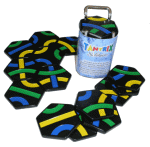
The Solitaire is a deluxe version of the Discovery set, and contains 14 tiles instead of 10. With all 14 tiles you can play the game of "Tantrix Solitaire" - a combination of Tantrix Discovery and traditional solitaire card games. The tiles themselves are more elegant - slightly larger, subtly curved on the top and bottom surfaces, and about four times the weight of standard tiles. Solitaire sets are available in four colour combinations: no-red, no blue, no yellow and no green tiles. Combining all four sets creates a deluxe version of the 56 tiles strategy game, though be warned - the tiles are only numbered 1-14 on the back, not 1 to 56. |
||
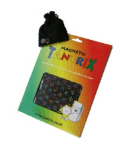 2005: Magnetic Tantrix
2005: Magnetic TantrixMagnetic Tantrix is made for players on the go. It is ideal at times when there is no table to play on or during "delayed" games where players make moves every once in a while. This magnetic set is also useful for saving your attempts at the hardest puzzles to come back to later. We kept the designs on the 56 tiles the same as those found in the Tantrix Game Pack. However, the numbers on the back of the Magnetic Tantrix tiles are all white, as opposed to being colour-coded. This makes the Discovery puzzles in this set more challenging, and also means that the five "Rainbow puzzles" of the Game Pack are not included. |
||
2006: Tantrix Match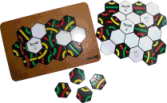 Tantrix Match was first introduced into the New Zealand market, and subsequently to other countries where it went on to win the "Australian Puzzle of the Year" in 2010. The puzzles use an addictive new concept combining the geometry and beauty of the Tantrix game with the deductive logic of sudoku. To play, a card is placed into the tray, the starting tiles are copied and the puzzle is solved by fitting the remaining tiles to make all colours match.
Tantrix Match was first introduced into the New Zealand market, and subsequently to other countries where it went on to win the "Australian Puzzle of the Year" in 2010. The puzzles use an addictive new concept combining the geometry and beauty of the Tantrix game with the deductive logic of sudoku. To play, a card is placed into the tray, the starting tiles are copied and the puzzle is solved by fitting the remaining tiles to make all colours match.
With over 22 million puzzles possible, the difficulty of each puzzle depends on the number and location of pre-placed tiles. Match consists of a wooden tray, 13 tiles and 12 puzzle cards of increasing difficulty. In addition, you may be able to use your Match set to solve puzzles published on the internet, in newspapers or by buying extension packs. Three add-on packs are currently available, the Family, Student and Expert editions. |
||
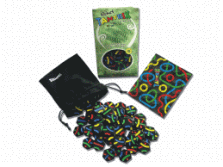 2006: Pocket Tantrix
2006: Pocket TantrixFinally, a lightweight travel version of the popular game pack, inspired by the inventor's mountaineering friends. A full Tantrix pack weighs around half a kilo, and after carrying a standard set to high altitudes in the Himalayas, there had been demands for an "alpine" edition which just couldn't be ignored! The new pocket edition contains all the puzzles and games of the standard-sized set, yet only weighs 120 grams. The tiles are still hand painted and made from virtually unbreakable high density plastic. It's handy size and light weight makes it the perfect set for posting or travelling overseas. |
||
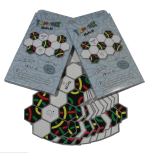 2007: Match Add-On Packs
2007: Match Add-On PacksTantrix Match had proven successful enough, add-on packs seemed the obvious next step. Student: A set of 12 cards of increasing difficulty, most quite easy but still suiting all ages, particularly anybody that is not experienced at solving Tantrix puzzles. Family: A set of 12 cards with an even mix of easy, moderate, and difficult puzzles. Expert: Also 12 cards of increasing difficulty, starting off at a moderate level but quickly becoming very hard indeed. Perfect for Tantrix fans and puzzle enthusiasts. |
||
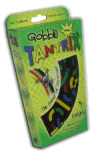 2009: Tantrix Gobble
2009: Tantrix GobbleTantrix Gobble was the next step in the evolution of Tantrix. This new variation of the TGP adds a party edition of the game called Gobble. Suitable for up to six players, Gobble is an interactive elbows-around-the-table game which rewards speed over strategy. In Gobble, it is easy to handicap players so adults, kids, experts, and novices can all compete evenly. Other improvements included are the new, easier to handle tiles, the softer bag, and the friendly, cartoonised instruction booklet. Of course, this edition still contains Tantrix Solitaire, over 40 puzzles and the award winning Tantrix Strategy game for 2-4 players. |
||
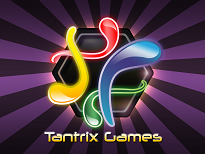 2010: Tantrix on Apple Devices
2010: Tantrix on Apple DevicesAn iOS version of Tantrix arrived at the Apple iTunes Store in 2010. The iPad-only Tantrix app is called "Tantrix Strategy" and an adaption of the tabletop version, allowing the multi-player game to be played with 2 people. There are three intelligence levels to choose from -- Clumsy, Trained and Deep Thought -- so everyone is guaranteed to find their match. And if you prefer to play against a real player rather than the AI, there are various ways to do this too. |
||
|
2012: Tantrix Quiz on Android The move towards digital versions continued two years later, and in 2012 Tantrix Quiz for Android devices was launched. The designers of Quiz came up with innovative new features which no other puzzles had used before, such as single-path clues. The result was a simple yet addictive app that challenges skills of deduction. Place all tiles onto the grid as fast as you can, while minimizing mistakes. A ranking system tracks scores and lets players know how they stand against everyone else. |
||
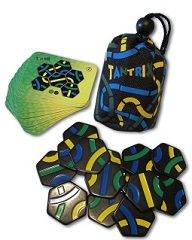 2015: Tantrix Puzzle Pack
2015: Tantrix Puzzle PackTantrix has gone through many stages since it was invented in 1988. The first tiles were made from cardboard, then plastic, finally resin and even foam, light weight and heavy - we tried them all. The first game rules were for just two players, then up to 4 and now Tantrix can be played as a party game for up to six people. The puzzles have evolved too - not just harder ones, but also more accessible challenges for all ages. In 2013 we started work on a solitaire edition designed to be the perfect travel companion - something lightweight, portable, rugged and that would give years of entertainment. After almost two years of development, the Tantrix Puzzle Pack was launched at Puzzling World, Wanaka New Zealand. The total number of puzzles is 40 and includes 26 card puzzles, a new version of Solitaire and the "Ultimate Quest". |
||
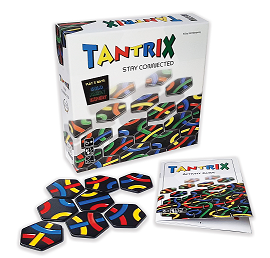
2021: The Game Box This latest edition is called the "Game Box" and represents over 30 years of game development. The Game Box contains the award winning multi-player game and enough solitaire puzzles and activities to last a lifetime, including the new "Tangle puzzle collection"! Inside the box you'll find 56 unique black tiles, all numbered and colour-coded on the reverse, a practical shuffle bag and the updated 11th edition of the illustrated activity guide.
|
© Copyright 2021, Colour of Strategy Ltd, Pohara, New Zealand. All rights reserved. Last update: October, 2021 |